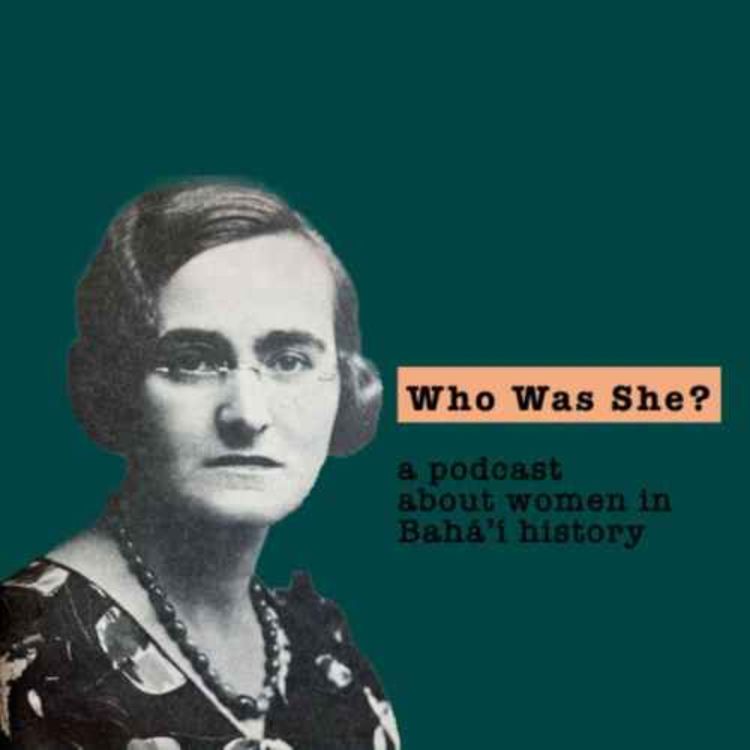Share

Who Was She?
Lidia Takes Initiative
In this episode, we learn more about how and why a young Lidia became an active Esperantist and meet Martha Root, her spiritual mother who taught her the Baha’i Faith.
TRANSCRIPT:
Welcome to Who was she? Podcast where I, Tara Jabbari share the stories of women throughout Baha’i history. This season is about the life of Lidia Zamenhof, an esperantist and Baha’i who traveled through three continents to teach languages in efforts to bring unity to humankind.
In the previous episode, we learned about Lidia’s father, Ludwik Zamenhof and how he developed his new language, Esperanto. In this episode we will learn how Lidia became an active Esperantist and was starting to be seen as a new leader for the Esperanto movement.
As the family continued to grieve, Klara took Ludwik’s passing the hardest. Lidia often wrote how she witnessed her mother age suddenly. But she had a duty to be strong for her children, especially for her teenage daughter and to continue her husband’s work progressing Esperanto.
For Lidia, when she was a girl, she actually did not like learning Esperanto. Slightly embarrassed, her parents continued to speak with her in the language but she was stubborn and independent, refusing to respond in Esperanto. However, eventually, she did see that the language was an example of bridging gaps between people and it’s significance in theirs and others lives. In later years, all of her letters were written solely in Esperanto. She witnessed how many people Bonvenigis, or welcomed a language that would striving for unity during a world war.
By 1918, World War 1 ended and Poland became an independent nation after over 100 years. The country now found itself poor and overpopulated. the Jews suffered greatly and anti-semitic violence broke out in 130 towns and villages throughout Poland. The country found itself clashing with the Red Army and there continued to be a lot of unrest throughout the neighboring countries.
A teenage Lidia took initiative and began translating literature into Esperanto. Lidia began her mission, she would propagate the Esperanto language in order to fulfill her father’s wishes. As she grew older, her cousins and neighbors wrote that she was of slight build, not handsome but had an “interesting face.” When it came to going to university, Lidia did not go the traditional route of medicine like her siblings. Instead, she was accepted into the University Of Warsaw with the intention of studying law, just as her mother wished. Even though she was of Jewish background and anti-Semitism was in high gear, she was able to be accepted into the Polish university where, at the time, had a strict quota of limiting how many Jews could attend university. While her mother’s wishes were fulfilled, Lidia revealed to a friend that her heart was not into the subject. She continued to work hard in school and in Esperanto while falling victim to prejudice and anger by her fellow Polish citizens for her background.
During the Universal Congress of Esperanto in 1924, Lidia accompanied her mother who was fragile, and suffering from liver cancer. One of the speakers that year was Edmond Privat, a disciple of Ludwik. He spoke of what is needed by Esperantists today, “Our task is very clear: we must slay the dark dragon of misunderstanding among peoples, we must spread that language in which dwells the youthful spirit of the new humanity.”
Inspired, Lidia began to take a more public role in the Esperanto movement. Soon, Esperantists learned there was another passionate Zamenhof who expressed openly and fearlessly of the need for unity.
After World War I, the Esperanto language grew with new people learning the language everyday. In 1924, the League of Nations and the Universal Telegraph Unions unanimously recognized Esperanto as a “klara lingvo” or “clear language” for telegraphy.
It was also the year Klara Zamenoff passed away. With the matriarch gone, Espernatists hoped another member of the Zamenhof family would become a leader in their movement, particularly the eldest child, Adam. But Adam had other responsibilities with his own family and his growing medical practice. Zofia, was also busy pursing her career in medicine.
It would be Lidia, now 20 years old, who would carry on her father’s passion project. She no longer had her long blond hair in braids, replacing it with a short bob that was common for the time and was only 5 feet tall but the petite Lidia became more active in the Esperanto Conferences, she would be recognized for her “thoughtful blue eyes.”
Unusual for the time, Lidia never married or had children. It was recalled that at least six Zamenhof women did not marry at all, including Zofia, Lidia’s sister. Instead, the real expectation was to be doing some kind of work which was a service to humanity. While Zofia became a doctor, Lidia would become a teacher of the Esperanto language, traveling across oceans and influencing all that crossed her path.
Lidia was less intrigued of home making, having never learned how to cook, was shy and could be introverted. She also had few true friends that she confided in. One Esperantist, recalled, “The young men used to say Lidia Zamenhof has only one lover, which is the Esperanto language!”
Lidia was more interested in the life of an intellectual and believed, similarly to her father that world peace could not be accomplished until all the peoples of the world could communicate with each other. Esperanto was the ideal means for that. She also identified herself as an atheist, having witnessed and been victim to how religious persecution only tore people apart.
But the Seventeenth Universal Congress of Esperanto held in Geneva, Switzerland would introduce Lidia to someone who would change her life forever.
She would meet an American journalist, teacher, and Esperantist, Martha Root. They would bond over the common interest to bring peace for people through the power of language. Martha herself was a member of the Baha’i Faith, and believed in the power of religion. This was the same faith that spoken to Ludwik Zamenhof, and the same faith whose followers were encouraged to learn Esperanto.
This meeting united these women so closely that they referred to each other lovingly as spiritual mother and daughter. Lidia was now inspired to travel and teach Esperanto across borders and oceans.
On the next episode, we learn more about Martha Root and her influence on Lidia.
You can also find more information on our Instagram, Facebook and Pinterest @whowasshe podcast. And please, rate and subscribe wherever you listen to this podcast. Logo was designed by Angela Musacchio. Music was composed and performed by Sam Redd. I am your host, Tara Jabbari.
More episodes
View all episodes

9. Bonus episode! BTS on Carole Lombard!
44:06||Season 4, Ep. 9A conversation with host Tara and her friend, Angie. Learn how this podcast season came about, the challenges, the creative process, and the people who helped make this season! We have a website! https://www.podpage.com/whowasshepodcast/You can also find more information on our social media:http://instagram.com/whowasshepodcasthttps://www.facebook.com/whowasshepodcasthttps://www.pinterest.com/whowasshepodcastOur music composer, Sam Redd is on SoundCloud as "Sam Redd": https://soundcloud.com/samreddand YouTube as @SammyManhattan: https://www.youtube.com/@sammymanhattanSubscribe on your favorite podcast platform: https://pod.link/1548368026
8. It's Been An Honor
18:49||Season 8, Ep. 8In our last episode of the season, we find out the challenges of Carole's love story with Clark Gable, her connections to some familiar names, her efforts to help during World War II, and her untimely death.We have a website! https://www.podpage.com/whowasshepodcast/You can also find more information on our social media:http://instagram.com/whowasshepodcasthttps://www.facebook.com/whowasshepodcasthttps://www.pinterest.com/whowasshepodcastOur music composer, Sam Redd is on SoundCloud as "Sam Redd": https://soundcloud.com/samreddand YouTube as @SammyManhattan: https://www.youtube.com/@sammymanhattanSubscribe on your favorite podcast platform: https://pod.link/1548368026
7. The Greatest Love Story
13:46||Season 4, Ep. 7How did Carole and Clark Gable finally become a couple? Why does "Gone with the Wind" have anything to do with it? Find out in the latest episode! We have a website! https://www.podpage.com/whowasshepodcast/You can also find more information on our social media:http://instagram.com/whowasshepodcasthttps://www.facebook.com/whowasshepodcasthttps://www.pinterest.com/whowasshepodcastOur music composer, Sam Redd is on SoundCloud as "Sam Redd": https://soundcloud.com/samreddand YouTube as @SammyManhattan: https://www.youtube.com/@sammymanhattanSubscribe on your favorite podcast platform: https://pod.link/1548368026
6. Her Greatest Heartbreak
08:09||Season 4, Ep. 6Two major deaths occur that impact Carole's life, which drives her to work harder in Hollywood. We have a website! https://www.podpage.com/whowasshepodcast/You can also find more information on our social media:http://instagram.com/whowasshepodcasthttps://www.facebook.com/whowasshepodcasthttps://www.pinterest.com/whowasshepodcastOur music composer, Sam Redd is on SoundCloud as "Sam Redd": https://soundcloud.com/samreddand YouTube as @SammyManhattan: https://www.youtube.com/@sammymanhattanSubscribe on your favorite podcast platform: https://pod.link/1548368026
5. The Studios Trading Girl
11:45||Season 4, Ep. 5In this episode, Carole grows in her career, building her reputation as the comedic actress in Hollywood, working with major studios like Paramount and Columbia, making seven films back to back in one year, navigating a failing marriage, and much more!We have a website! https://www.podpage.com/whowasshepodcast/You can also find more information on our social media:http://instagram.com/whowasshepodcasthttps://www.facebook.com/whowasshepodcasthttps://www.pinterest.com/whowasshepodcastOur music composer, Sam Redd is on SoundCloud as "Sam Redd": https://soundcloud.com/samreddand YouTube as @SammyManhattan: https://www.youtube.com/@sammymanhattanSubscribe on your favorite podcast platform: https://pod.link/1548368026
4. Mrs. Carole Powell
10:33||Season 4, Ep. 4Carole gets married, becomes the favorite client for the infamous talent agent, Myron Selznick, and holds her own against Harry Cohen, aka "The most hated man in Hollywood," plus much more! We have a website! https://www.podpage.com/whowasshepodcast/You can also find more information on our social media:http://instagram.com/whowasshepodcasthttps://www.facebook.com/whowasshepodcasthttps://www.pinterest.com/whowasshepodcastOur music composer, Sam Redd is on SoundCloud as "Sam Redd": https://soundcloud.com/samreddand YouTube as @SammyManhattan: https://www.youtube.com/@sammymanhattanSubscribe on your favorite podcast platform: https://pod.link/1548368026
3. The Orchid Lady
07:06||Season 4, Ep. 3In the third episode of this new season, we follow Lombard's transformation from a struggling actress to becoming Paramount Pictures' "Orchid," how she earned the respect of Hollywood, and more! We have a website! https://www.podpage.com/whowasshepodcast/You can also find more information on our social media:http://instagram.com/whowasshepodcasthttps://www.facebook.com/whowasshepodcasthttps://www.pinterest.com/whowasshepodcastOur music composer, Sam Redd is on SoundCloud as "Sam Redd": https://soundcloud.com/samreddand YouTube as @SammyManhattan: https://www.youtube.com/@sammymanhattanSubscribe on your favorite podcast platform: https://pod.link/1548368026
2. Introducing Carol Lombard
18:11||Season 4, Ep. 2This season is about one of Hollywood's first starlets, Carole Lombard and in this second episode, we learn about how she went from Jane Peters to her new screen name, Carol (without the e) Lombard, auditioning and avoiding the infamous 'casting couch' with Charlie Chaplin and John Barrymore, the car crash that nearly ended her career, and more!We have a website! https://www.podpage.com/whowasshepodcast/You can also find more information on our social media:http://instagram.com/whowasshepodcasthttps://www.facebook.com/whowasshepodcasthttps://www.pinterest.com/whowasshepodcastOur music composer, Sam Redd is on SoundCloud as "Sam Redd": https://soundcloud.com/samreddand YouTube as @SammyManhattan: https://www.youtube.com/@sammymanhattan Subscribe on your favorite podcast platform: https://pod.link/1548368026
1. Who was Jane Peters?
10:32||Season 4, Ep. 1Welcome to Who was she? Podcast where your host, Tara Jabbari focuses on the stories of women throughout history that were active in the Baha’i Faith. This season is about one of Hollywood's first starlets, Carole Lombard.This first episode shares the story of her early beginnings from Indiana to what led to her family moving to Los Angeles. We have a website! https://www.podpage.com/whowasshepodcast/ You can also find more information on our social media:http://instagram.com/whowasshepodcasthttps://www.facebook.com/whowasshepodcasthttps://www.pinterest.com/whowasshepodcastSubscribe on your favorite podcast platform: https://pod.link/1548368026